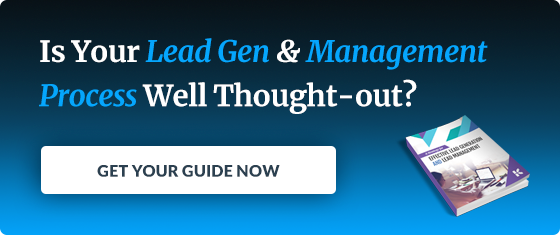
Marketing Automation:
What You Need to Know
However, marketing automation tools can’t close more deals on their own. Here’s what you need to know to make sure you’re leveraging marketing automation to complement and scale existing efforts.
What is Marketing Automation?
Marketing automation refers to any marketing software that automates marketing efforts and processes (specifically repetitive and tedious tasks and complex workflows) to help increase your marketing team’s operational efficiency. Marketing automation tools can be used to enhance your content promotion, social media engagement and email campaigns or carry out strategic sales methodologies like lead management and lead scoring.
However, marketing automation is not…
- A replacement for your marketing team
- A “set it and forget it” solution
- A way to spam your customers
The most effective marketing teams automate only the most monotonous and highly technical aspects of their job so they can focus on building creative campaigns that address buyer personas’ key pain points and help them overcome their challenges human-to-human.
What are the Benefits of Marketing Automation Tools?
If you choose to adopt tools like those available through HubSpot marketing automation, you can expect the following benefits:
- Improved productivity: Entering lead information manually and building contact lists one-by-one isn’t just boring, it’s also inefficient. Automating these tasks allows you to dedicate more time and energy to other, more pressing tasks.
- Marketing and sales alignment: The most significant threat to alignment of your sales and marketing teams is poor communication, but automating documentation ensures both teams have all the data they need. For example, using a platform that can automatically track leads’ digital behavior across every touchpoint and marketing channel allows sales to have more meaningful and productive conversations when the lead is ready. Additionally, sales reps can be automatically notified a lead is ready for a conversation based on this behavioral data and reach out when the lead is hot.
- Simpler multi-channel integration: Most buyers engage with a brand across multiple channels before they make a decision. But without automation, it can be challenging to make sure your message remains relevant to their current stage in the buyer’s journey. Plus, automation allows for better visibility into which efforts are most likely to drive action.
- Easier campaign tracking and measurement: Marketing automation tools help track, monitor and measure each tactic within a campaign so you can determine what’s working, what you should change and how to replicate success on-the-fly. It can also help translate massive quantities of data into easy-to-understand reports.
How Does Marketing Automation Align with Inbound Marketing?
You may have heard marketing automation and inbound marketing are conflicting ideas because marketing automation perpetuates cold, robotic communication while inbound marketing focuses on human interaction and authentic engagement. However, they are not mutually exclusive. Inbound marketing is a method and marketing automation is a tool, and you can easily leverage marketing automation to help improve your inbound efforts through a process called marketing funnel automation.
Let’s take a look at an example:
Imagine a potential customer is scrolling through their social media feed when they see an ad for a free eBook that discusses a pain point they are experiencing from your company. Interested, they click through to the gated landing page and fill out the form to download the content. Because this new prospect did not immediately complete a purchase, they’re added to a nurture list and a workflow. Each email in the workflow has been carefully composed by the marketing team, and uses tokens to automatically personalize the messages as much as possible based on the information you have.
A few weeks later, the same contact engages with your brand on another social media platform, searches for reviews of your product on Google and navigates to a product page. Each of these interactions is taken into account so you can move the contact into a more appropriate bucket and ensure the messages you’re delivering are reflective of the contact’s stage in the buyer’s journey. It may make sense here to automatically provide (through email or ads) a buyer’s guide your team created to compare industry options.
In this case, the sophisticated contact lists, workflow and personalization are all possible because of tools like HubSpot marketing automation. You’re able to marry together the technology with inbound concepts to create a streamlined user experience.
What to Consider When Building a Marketing Automation Strategy
Before you invest in a marketing automation platform and begin activating various tools, you first need to consider how automating aspects of your processes will impact your marketing goals. When marketing automation fails, it’s usually because the team was trying to automate too much, or not taking the time to determine how automation would impact the buyer’s experience.
Here are three things you need to do to ensure success with marketing automation:
- Align your automation with your personas’ buyer’s journey.
At what point in the journey do people get stuck? Where can you accelerate the journey? For example, you may determine that during the decision-phase of the sales funnel, prospects have a hard time justifying your solution’s higher price tag. Supplying a case study or buyer’s guide via marketing automation when the prospect reaches this stage could tip the scales in your favor. - Bring the sales team into the conversation—and solve their challenges.
Be sure to collaborate with the sales team to determine where reps are encountering challenges and what data and information might support their efforts. For example, you may find the sales team’s follow-up emails are not garnering the open rates you’d expect. It may be worthwhile to create a few email templates based on data (that shows which emails get the most opens and replies) and utilize personalization tokens. The emails can even be attached to a workflow that contacts prospects after a few days of having a proposal in hand. Additionally, sales funnel automation strategies can be used to help sales reps ensure the right deals get the right attention. - Use automation for internal notifications to plug holes in the sales process.
Automation is just as useful (if not more so) for internal notifications as it is for communicating with your contacts. For example, one company set up alerts for when leads revisit their site. The sales rep noticed one lead visited 15 product pages but never made a purchase. He gave the lead a call and discovered that the prospect couldn’t find what he was looking for, but placed a large order over the phone. Without marketing automation, the company would have missed that sale and never known an issue existed with product web pages.
Strategic use of marketing automation tools can help enhance your bottom line. By automating the right tasks, you can drive faster conversions and larger ROI, and create more memorable and meaningful experiences for your prospects. And as technology becomes more powerful, opportunities to automate elements of your marketing will only continue to grow. But while you should use tools that make your job easier and drive better outcomes, remember: they’re no substitute for genuine, human-to-human interaction.
- © Kuno Creative - All Rights Reserved
- Privacy
- Terms & Conditions
- 3248 West Erie, Lorain, OH 44053
- 800.303.0806




